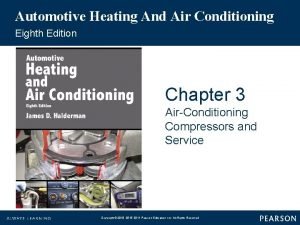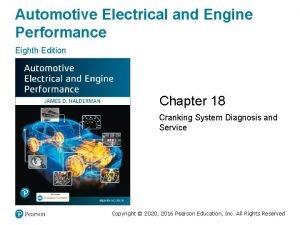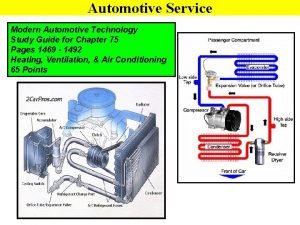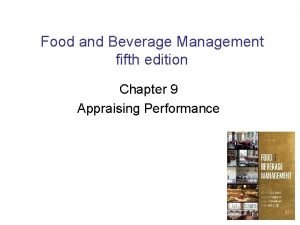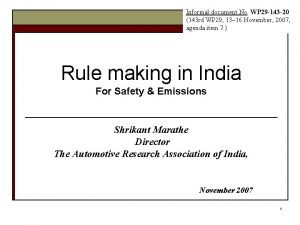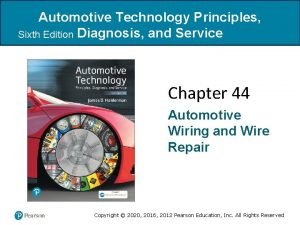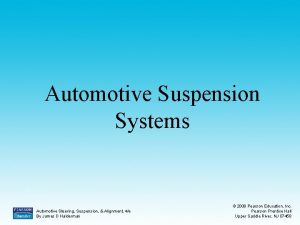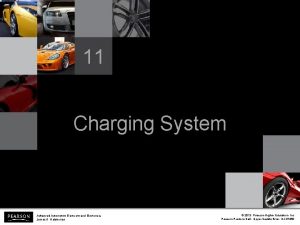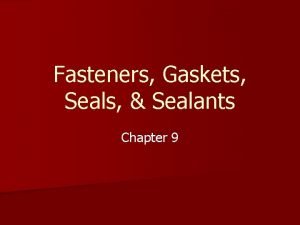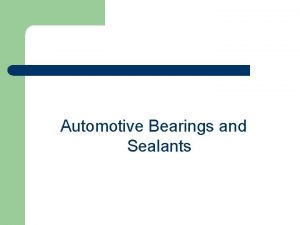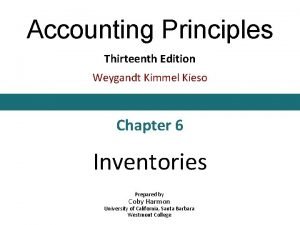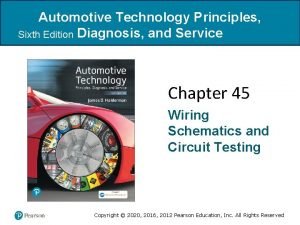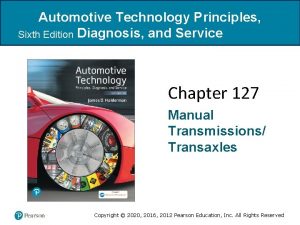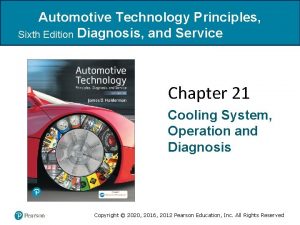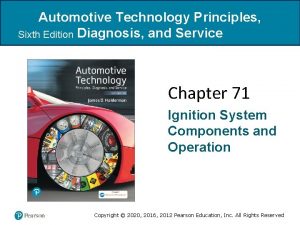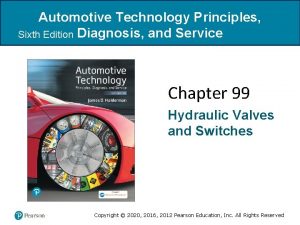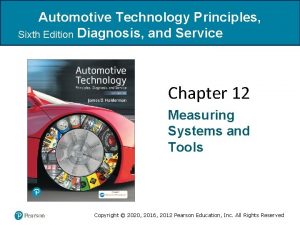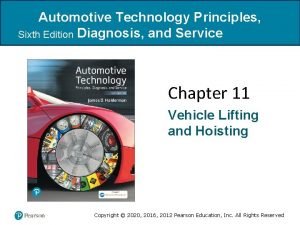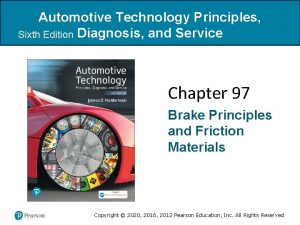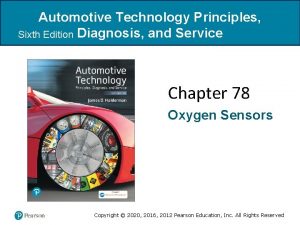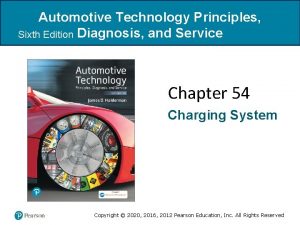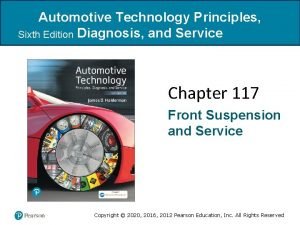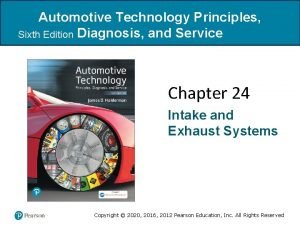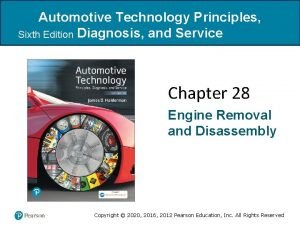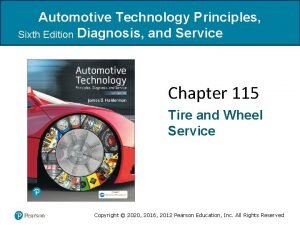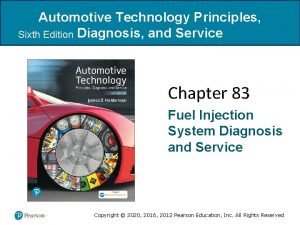Automotive Technology Principles Sixth Edition Diagnosis and Service





































































- Slides: 69

Automotive Technology Principles, Sixth Edition Diagnosis, and Service Chapter 26 Engine Condition Diagnosis Copyright © 2018, 2015, 2011 Pearson Education, Inc. All Rights Reserved Copyright © 2020, 2016, 2012 Pearson Education, Inc. All Rights Reserved

LEARNING OBJECTIVES (1 of 2) 26. 1 Discuss typical engine-related complaints and engine smoke diagnosis. 26. 2 Discuss the importance of the driver’s description and visual checks. 26. 3 Discuss engine noise diagnosis. 26. 4 Explain oil pressure testing and the purpose of oil pressure warning lamps. Copyright © 2020, 2016, 2012 Pearson Education, Inc. All Rights Reserved

LEARNING OBJECTIVES (2 of 2) 26. 5 Explain compression testing, and compare wet and running compression tests. 26. 6 Describe cylinder leakage test and cylinder power balance test. 26. 7 Explain the vacuum test and exhaust restriction test. 26. 8 Explain how to test back pressure with a vacuum gauge and a pressure gauge, and how to diagnose head gasket failure. 26. 9 Discuss the operation of dash warning lights. Copyright © 2020, 2016, 2012 Pearson Education, Inc. All Rights Reserved

TYPICAL ENGINE-RELATED COMPLAINTS • Excessive oil consumption • Engine misfiring • Loss of power • Smoke from the engine or exhaust • Engine noise Copyright © 2020, 2016, 2012 Pearson Education, Inc. All Rights Reserved

ENGINE SMOKE DIAGNOSIS • Blue: Indicates the engine is burning oil. • Black: Indicates excessive fuel in the combustion chamber. • White (steam): Indicates water (coolant) in the combustion chamber. Copyright © 2020, 2016, 2012 Pearson Education, Inc. All Rights Reserved

Figure 26. 1 Blowby gases coming out of the crankcase vent hose. As seen on this old high-mileage engine, excessive amounts of combustion gases flow past the piston rings and into the crankcase Copyright © 2020, 2016, 2012 Pearson Education, Inc. All Rights Reserved

Figure 26. 2 White steam is usually an indication of a blown (defective) cylinder head gasket that allows engine coolant to flow into the combustion chamber where it is turned into steam Copyright © 2020, 2016, 2012 Pearson Education, Inc. All Rights Reserved

QUESTION 1: ? What does blue exhaust smoke indicate? Copyright © 2020, 2016, 2012 Pearson Education, Inc. All Rights Reserved

ANSWER 1: The engine has an oil consumption concern. Copyright © 2020, 2016, 2012 Pearson Education, Inc. All Rights Reserved

THE DRIVER IS YOUR BEST RESOURCE • Ask the following questions: • When did the problem first occur? • Under what conditions does it occur? – – Cold or hot? Acceleration, cruise, deceleration? How far was it driven? What recent repairs have been performed? Copyright © 2020, 2016, 2012 Pearson Education, Inc. All Rights Reserved

TECH TIP Copyright © 2020, 2016, 2012 Pearson Education, Inc. All Rights Reserved

VISUAL CHECKS • Oil level and condition • Coolant level and condition • Oil leaks Copyright © 2020, 2016, 2012 Pearson Education, Inc. All Rights Reserved

Figure 26. 3 What looks like an oil pan gasket leak can be a rocker cover gasket leak. Always look for the highest and most forward place you see oil leaking; that should be repaired first Copyright © 2020, 2016, 2012 Pearson Education, Inc. All Rights Reserved

Figure 26. 4 The transmission and flexplate (flywheel) were removed to check the exact location of this oil leak. The rear main seal and/or the oil pan gasket could be the cause of this leak Copyright © 2020, 2016, 2012 Pearson Education, Inc. All Rights Reserved

Figure 26. 5 Using a black light to spot leaks after adding dye to the oil Copyright © 2020, 2016, 2012 Pearson Education, Inc. All Rights Reserved

ENGINE NOISE DAIGNOSIS • Engine noises are often difficult to diagnose. Several items that can cause an engine noise include: – – – – Valves clicking Torque converter Cracked flex plate Loose or defective drive belts or tensioners. Piston pin knock Timing chain noise Rod or main bearing noise Copyright © 2020, 2016, 2012 Pearson Education, Inc. All Rights Reserved

Figure 26. 6 An accessory belt tensioner. Most tensioners have a mark that indicates normal operating location. If the belt has stretched, this indicator mark will be outside of the normal range. Anything wrong with the belt or tensioner can cause noise Copyright © 2020, 2016, 2012 Pearson Education, Inc. All Rights Reserved

Figure 26. 7 A cracked exhaust manifold on a Ford V-8 Copyright © 2020, 2016, 2012 Pearson Education, Inc. All Rights Reserved

OIL PRESSURE TESTING • Proper oil pressure is very important for the operation of any engine. • Low oil pressure can cause engine wear, and engine wear can cause low oil pressure. • Other issues include: – Low oil level – Diluted oil – Stuck oil pressure relief valve • The oil pressure warning lamp will. illuminate when pressures drop below 4 -7 PSI. Copyright © 2020, 2016, 2012 Pearson Education, Inc. All Rights Reserved

Figure 26. 8 To measure engine oil pressure, remove the oil pressure sending (sender) unit usually located near the oil filter. Screw the pressure gauge into the oil pressure sending unit hole Copyright © 2020, 2016, 2012 Pearson Education, Inc. All Rights Reserved

TECH TIP Copyright © 2020, 2016, 2012 Pearson Education, Inc. All Rights Reserved

Figure 26. 9 A Tech 2 scan tool display showing a fault with cylinder 3. Once the cylinder has been identified, then more detailed tests can be performed to determine the root cause, which could be an ignition, fuel or mechanical issue Copyright © 2020, 2016, 2012 Pearson Education, Inc. All Rights Reserved

Figure 26. 10 The Ford IDS scan tool has a graph function that allows the technician to view the data on the cylinder contribution test visually, making diagnosis easier. In this example, the cylinders on bank 2 on a Ford V-8 (cylinders 7, 6, 5, and 8) are weak Copyright © 2020, 2016, 2012 Pearson Education, Inc. All Rights Reserved

TECH TIP Copyright © 2020, 2016, 2012 Pearson Education, Inc. All Rights Reserved

Figure 26. 11 The paper test involves holding a piece of paper near the tailpipe of an idling engine. A good engine should produce even, outward puffs of exhaust. If the paper is sucked in toward the tailpipe, a burned valve is a possibility Copyright © 2020, 2016, 2012 Pearson Education, Inc. All Rights Reserved

COMPRESSION TEST • Cranking compression test – Dry – Wet • Running (dynamic) compression test • Relative compression test • Cylinder leakage test Copyright © 2020, 2016, 2012 Pearson Education, Inc. All Rights Reserved

Figure 26. 12 A two-piece compression gauge set. The threaded hose is screwed into the spark plug hole after removing the spark plug. The gauge part is then snapped onto the end of the hose Copyright © 2020, 2016, 2012 Pearson Education, Inc. All Rights Reserved

TECH TIP Copyright © 2020, 2016, 2012 Pearson Education, Inc. All Rights Reserved

Figure 26. 13 Use a vacuum or fuel line hose over the spark plug to install it without danger of cross-threading the cylinder head Copyright © 2020, 2016, 2012 Pearson Education, Inc. All Rights Reserved

Figure 26. 14 Badly burned exhaust valve. A compression test could have detected a problem, and a cylinder leakage test (leakdown test) could have been used to determine the exact problem Copyright © 2020, 2016, 2012 Pearson Education, Inc. All Rights Reserved

Figure 26. 15 (a) A relative compression test using an amp clamp around the starter motor power cable and a Pico scope. (b) The result is a waveform that displays the current needed for each cylinder is the same, indicating that all cylinders have the same relative compression Copyright © 2020, 2016, 2012 Pearson Education, Inc. All Rights Reserved

Figure 26. 16 A typical handheld cylinder leakage tester Copyright © 2020, 2016, 2012 Pearson Education, Inc. All Rights Reserved

Figure 26. 17 A whistle stop used to find top dead center. Remove the spark plug and install the whistle stop, then rotate the engine by hand. When the whistle stops making a sound, the piston is at the top Copyright © 2020, 2016, 2012 Pearson Education, Inc. All Rights Reserved

QUESTION 2: ? What the three types of compression test? Copyright © 2020, 2016, 2012 Pearson Education, Inc. All Rights Reserved

ANSWER 2: Cranking, running and relative compression tests. Copyright © 2020, 2016, 2012 Pearson Education, Inc. All Rights Reserved

CYLINDER BALANCE TEST • The purpose of a cylinder power balance test is to determine if all cylinders are contributing power equally. • The acceptable method of canceling cylinders, which will work on all types of ignition systems, including distributorless, is to ground the secondary current for each cylinder. Copyright © 2020, 2016, 2012 Pearson Education, Inc. All Rights Reserved

Figure 26. 18 Using a vacuum hose and a test light to ground one cylinder at a time on a distributorless ignition system. Copyright © 2020, 2016, 2012 Pearson Education, Inc. All Rights Reserved

VACUUM TESTS • Vacuum is pressure below atmospheric pressure and is measured in inches (or millimeters) of mercury (Hg). • Cranking Vacuum Test • Idle Vacuum Test • Low and Steady Vacuum • Fluctuating Vacuum Copyright © 2020, 2016, 2012 Pearson Education, Inc. All Rights Reserved

Figure 26. 19 An engine in good mechanical condition should produce 17 to 21 inch Hg of vacuum at idle at sea level Copyright © 2020, 2016, 2012 Pearson Education, Inc. All Rights Reserved

Figure 26. 20 A steady but low reading could indicate retarded valve or ignition timing Copyright © 2020, 2016, 2012 Pearson Education, Inc. All Rights Reserved

Figure 26. 21 A gauge reading with the needle fluctuating 3 to 9 inch Hg below normal often indicates a vacuum leak in the intake system Copyright © 2020, 2016, 2012 Pearson Education, Inc. All Rights Reserved

Figure 26. 22 A leaking head gasket can cause the needle to vibrate as it moves through a range from below to above normal Copyright © 2020, 2016, 2012 Pearson Education, Inc. All Rights Reserved

Figure 26. 23 An oscillating needle 1 or 2 inch Hg below normal could indicate an incorrect air-fuel mixture (either too rich or too lean) Copyright © 2020, 2016, 2012 Pearson Education, Inc. All Rights Reserved

Figure 26. 24 A rapidly vibrating needle at idle that becomes steady as engine speed is increased indicates worn valve guides Copyright © 2020, 2016, 2012 Pearson Education, Inc. All Rights Reserved

Figure 26. 25 If the needle drops 1 or 2 inch Hg from the normal reading, one of the engine valves is burned or not seating properly Copyright © 2020, 2016, 2012 Pearson Education, Inc. All Rights Reserved

Figure 26. 26 Weak valve springs will produce a normal reading at idle, but as engine speed increases, the needle will fluctuate rapidly between 12 and 24 inch Hg Copyright © 2020, 2016, 2012 Pearson Education, Inc. All Rights Reserved

Figure 26. 27 A steady needle reading that drops 2 or 3 inch Hg when the engine speed is increased slightly above idle indicates that the ignition timing is retarded Copyright © 2020, 2016, 2012 Pearson Education, Inc. All Rights Reserved

Figure 26. 28 A steady needle reading that rises 2 or 3 inch Hg when the engine speed is increased slightly above idle indicates that the ignition timing is advanced Copyright © 2020, 2016, 2012 Pearson Education, Inc. All Rights Reserved

Figure 26. 29 A needle that drops to near zero when the engine is accelerated rapidly and then rises slightly to a reading below normal indicates an exhaust restriction Copyright © 2020, 2016, 2012 Pearson Education, Inc. All Rights Reserved

QUESTION 3: ? What does a fluctuating vacuum gauge indicate? Copyright © 2020, 2016, 2012 Pearson Education, Inc. All Rights Reserved

ANSWER 3: A vacuum leak in the intake system. Copyright © 2020, 2016, 2012 Pearson Education, Inc. All Rights Reserved

EXHAUST RESTRICTION TEST • Common causes of restricted exhaust include the following: – Clogged catalytic converter – Clogged or restricted muffler – Damaged or defective piping • Test back pressure: – With a vacuum gauge – With a pressure gauge Copyright © 2020, 2016, 2012 Pearson Education, Inc. All Rights Reserved

Figure 26. 30 A technician-made adapter used to test exhaust system back pressure Copyright © 2020, 2016, 2012 Pearson Education, Inc. All Rights Reserved

DIAGNOSING HEAD GASKET FAILURE • Several items can be used to help diagnose a head gasket failure. – – Exhaust gas analyzer Chemical test Bubbles in coolant Excessive exhaust steam Copyright © 2020, 2016, 2012 Pearson Education, Inc. All Rights Reserved

Figure 26. 31 A tester that uses a blue liquid to check for exhaust gases in the exhaust, which would indicate a head gasket leak problem Copyright © 2020, 2016, 2012 Pearson Education, Inc. All Rights Reserved

COMPRESSION TEST Copyright © 2020, 2016, 2012 Pearson Education, Inc. All Rights Reserved

1. The tools and equipment needed to perform a compression test include a compression gauge, an air nozzle, and the socket ratchets and extensions that may be necessary to remove the spark plugs from the engine. Copyright © 2020, 2016, 2012 Pearson Education, Inc. All Rights Reserved

2. To prevent ignition and fuel-injection operation while the engine is being cranked, remove both the fuel injection fuse and the ignition fuse. Copyright © 2020, 2016, 2012 Pearson Education, Inc. All Rights Reserved

3. Block open the throttle (and choke, if the engine is equipped with a carburetor). Keeping the throttle open ensures that enough air will be drawn into the engine so that the compression test results will be accurate. Copyright © 2020, 2016, 2012 Pearson Education, Inc. All Rights Reserved

4. Before removing the spark plugs, use an air nozzle to blow away any dirt that may be around the spark plug. Copyright © 2020, 2016, 2012 Pearson Education, Inc. All Rights Reserved

5. Remove all of the spark plugs. Be sure to mark the spark plug wires so that they can be reinstalled onto the correct spark plugs after the compression test has been performed. Copyright © 2020, 2016, 2012 Pearson Education, Inc. All Rights Reserved

6. Select the proper adapter for the compression gauge. The threads on the adapter should match those on the spark plug. Copyright © 2020, 2016, 2012 Pearson Education, Inc. All Rights Reserved

7. If necessary, connect a battery charger to the battery before starting the compression test. It is important that consistent cranking speed be available for each cylinder being tested. Copyright © 2020, 2016, 2012 Pearson Education, Inc. All Rights Reserved

8. Make a note of the reading on the gauge after the first “puff, ” which indicates the first compression stroke that occurred on that cylinder as the engine was being rotated. Copyright © 2020, 2016, 2012 Pearson Education, Inc. All Rights Reserved

9. After the engine has been cranked for four “puffs, ” stop cranking the engine and observe the compression gauge. Copyright © 2020, 2016, 2012 Pearson Education, Inc. All Rights Reserved

10. Record the first puff and this final reading for each cylinder. The final readings should all be within 20% of each other. Copyright © 2020, 2016, 2012 Pearson Education, Inc. All Rights Reserved

11. If a cylinder(s) is lower than most of the others, use an oil can and squirt two squirts of engine oil into the cylinder and repeat the compression test. Copyright © 2020, 2016, 2012 Pearson Education, Inc. All Rights Reserved

12. If the gauge reading is now much higher than the first test results, then the cause of the low compression is due to worn or defective piston rings. Copyright © 2020, 2016, 2012 Pearson Education, Inc. All Rights Reserved

Copyright © 2020, 2016, 2012 Pearson Education, Inc. All Rights Reserved
 Automotive technology sixth edition
Automotive technology sixth edition Automotive technology sixth edition
Automotive technology sixth edition Principles of economics sixth edition
Principles of economics sixth edition The sixth sheik's sixth sheep's sick
The sixth sheik's sixth sheep's sick The sixth sick sheik's sixth sheep's sick lyrics
The sixth sick sheik's sixth sheep's sick lyrics Automotive heating and air conditioning 8th edition
Automotive heating and air conditioning 8th edition Biochemistry sixth edition
Biochemistry sixth edition Automotive engines 8th edition
Automotive engines 8th edition China automotive technology & research center
China automotive technology & research center Computer architecture a quantitative approach sixth edition
Computer architecture a quantitative approach sixth edition Apa sixth edition
Apa sixth edition Computer architecture a quantitative approach 6th
Computer architecture a quantitative approach 6th Precalculus sixth edition
Precalculus sixth edition Computer architecture a quantitative approach sixth edition
Computer architecture a quantitative approach sixth edition Steps of nursing process
Steps of nursing process Medical diagnosis and nursing diagnosis difference
Medical diagnosis and nursing diagnosis difference Second phase of nursing process
Second phase of nursing process Nursing process and critical thinking
Nursing process and critical thinking Modern automotive technology answer key
Modern automotive technology answer key Automotive technology chapter 51 answers
Automotive technology chapter 51 answers Structural mechanics exam questions
Structural mechanics exam questions Bob caat
Bob caat Mechanical technology automotive grade 10
Mechanical technology automotive grade 10 Sixth sense technology seminar report
Sixth sense technology seminar report Sixth sense technology seminar
Sixth sense technology seminar Pattie maes sixth sense
Pattie maes sixth sense Perbedaan diagnosis gizi dan diagnosis medis
Perbedaan diagnosis gizi dan diagnosis medis Chapter 81 brake system technology answers key
Chapter 81 brake system technology answers key Mis chapter 6
Mis chapter 6 Mis
Mis Computer security principles and practice
Computer security principles and practice Computer security principles and practice 4th edition
Computer security principles and practice 4th edition Expert systems: principles and programming, fourth edition
Expert systems: principles and programming, fourth edition Food and beverage service' 9 th edition
Food and beverage service' 9 th edition Food and beverage management book pdf
Food and beverage management book pdf Food and beverage operations management
Food and beverage operations management Food and beverage service' 9 th edition
Food and beverage service' 9 th edition Food and beverage service' 9 th edition
Food and beverage service' 9 th edition Qqq tea
Qqq tea Information technology project management 9th edition
Information technology project management 9th edition Blue project chapter 5
Blue project chapter 5 Ethics in information technology 6th edition answers
Ethics in information technology 6th edition answers Ethics in information technology fourth edition
Ethics in information technology fourth edition Information technology project management 8th edition
Information technology project management 8th edition Information technology project management 9th edition
Information technology project management 9th edition Basic environmental technology
Basic environmental technology Information technology project management 9th edition
Information technology project management 9th edition Automotive regulations and standards
Automotive regulations and standards Chapter 44 automotive wiring and wire repair
Chapter 44 automotive wiring and wire repair Halderman
Halderman Advanced automotive electricity and electronics
Advanced automotive electricity and electronics Chapter 2 automotive careers and ase certification
Chapter 2 automotive careers and ase certification Automotive maintenance and light repair answer key
Automotive maintenance and light repair answer key Fasteners gaskets seals and sealants
Fasteners gaskets seals and sealants Chapter 8 fasteners gaskets seals and sealants
Chapter 8 fasteners gaskets seals and sealants 3 types of sealants used in automotive
3 types of sealants used in automotive Failure of supporting utilities and structural collapse
Failure of supporting utilities and structural collapse Principles of electronic communication systems 3rd edition
Principles of electronic communication systems 3rd edition Principles of economics third edition politeknik
Principles of economics third edition politeknik Accounting principles second canadian edition
Accounting principles second canadian edition Accounting principles second canadian edition
Accounting principles second canadian edition Accounting principles second canadian edition
Accounting principles second canadian edition Principles of management by stephen robbins 13th edition
Principles of management by stephen robbins 13th edition Involuntary inactive real estate license florida
Involuntary inactive real estate license florida Principles of information system
Principles of information system Principles of information systems 11th edition
Principles of information systems 11th edition Principles of information security 4th edition
Principles of information security 4th edition Principles of marketing fifth european edition
Principles of marketing fifth european edition Accounting principles 13th edition
Accounting principles 13th edition Accounting principles second canadian edition
Accounting principles second canadian edition





